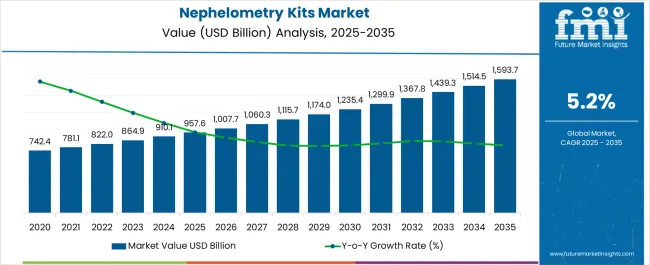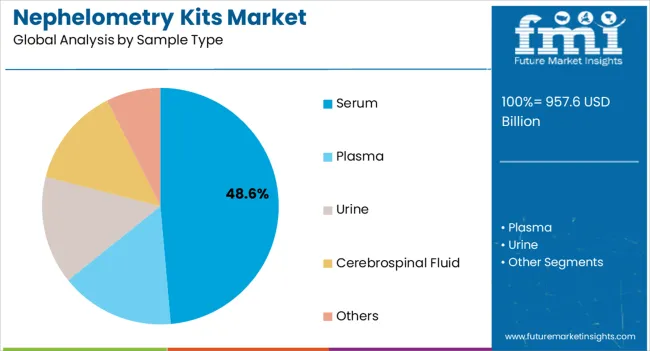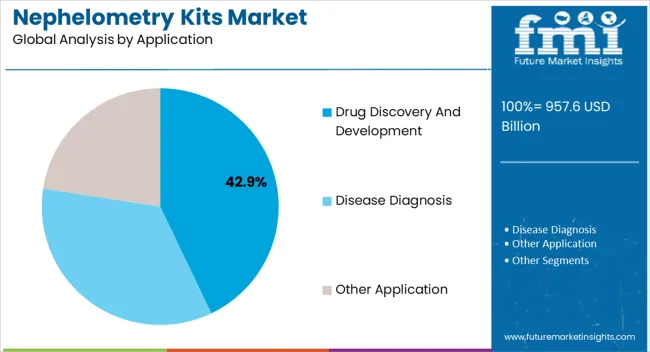The Nephelometry Kits Market is estimated to be valued at USD 957.6 billion in 2025 and is projected to reach USD 1593.7 billion by 2035, registering a compound annual growth rate (CAGR) of 5.2% over the forecast period.

| Metric | Value |
|---|---|
| Nephelometry Kits Market Estimated Value in (2025 E) | USD 957.6 billion |
| Nephelometry Kits Market Forecast Value in (2035 F) | USD 1593.7 billion |
| Forecast CAGR (2025 to 2035) | 5.2% |
The nephelometry kits market is witnessing consistent expansion owing to the rising demand for advanced diagnostic solutions in clinical laboratories and pharmaceutical research. The increasing incidence of chronic and infectious diseases has intensified the requirement for rapid and precise protein quantification methods.
Nephelometry offers superior sensitivity and reproducibility compared to conventional techniques, making it valuable for both diagnostic and research applications. The adoption of automated analyzers, advancements in assay design, and integration of nephelometric techniques into routine laboratory workflows are accelerating market penetration.
In addition, investments in pharmaceutical R and D and the focus on personalized medicine are boosting the use of nephelometry kits for biomarker detection and therapeutic monitoring. Regulatory standards promoting quality assurance in laboratory testing and the growing emphasis on evidence based diagnostics are further supporting market growth, ensuring a favorable outlook in the coming years.
The reagent kits segment is expected to represent 54.20% of total market revenue by 2025, making it the leading product category. Growth in this segment is being driven by the increasing demand for standardized and ready to use reagents that ensure accuracy and consistency in testing.
Their ease of use, compatibility with automated systems, and cost effectiveness are enhancing adoption across clinical laboratories and research institutions.
The ability to provide reliable results with minimal preparation has positioned reagent kits as the preferred choice in high throughput testing environments.

The serum segment is projected to hold 48.60% of total market revenue by 2025, reflecting its dominance in the sample type category. The reliability of serum as a sample for protein and biomarker analysis has reinforced its widespread use in both clinical diagnostics and research settings.
Its stability, accessibility, and established protocols for testing make it the standard sample type for nephelometric assays.
Growing use of serum based analysis in disease monitoring and pharmaceutical studies is expected to further consolidate its leadership.

The drug discovery and development segment is anticipated to account for 42.90% of total market revenue by 2025 within the application category, establishing it as the leading segment. Rising investments in pharmaceutical R and D and the growing focus on precision medicine are fueling demand for nephelometry kits in drug screening and validation processes.
Their capability to deliver accurate protein quantification and biomarker analysis is critical in assessing drug efficacy and safety.
Integration of nephelometry into early stage research and clinical trial workflows has strengthened its importance, ensuring sustained growth for this application segment.
From 2012 to 2025, the global nephelometry kits market experienced a CAGR of 2.7%, reaching a market size of USD 957.6 million in 2025.
From 2012 to 2025, Because nephelometry is becoming more widely used as a trustworthy and effective way to measure particular analytes in a variety of clinical and research applications, the market for nephelometry kits has historically shown stable expansion.
The diagnosis and follow-up of problems like autoimmune disorders, infectious diseases, cardiovascular diseases, and cancer have all benefited from the widespread use of nephelometry kits. Technology advances, elevated public awareness of the value of early disease detection, and the expanding prevalence of chronic diseases have all benefited the industry.
Future Forecast for Nephelometry Kits Industry:
Looking ahead, the global nephelometry kits industry is expected to rise at a CAGR of 5.5% from 2025 to 2035. During the forecast period, the market size is expected to reach USD 1593.7 billion by 2035.
The market will rise as a result of ongoing research and development projects aimed at enhancing nephelometry technology, creating new assays, and discovering novel biomarkers.
Innovation and the creation of cutting-edge nephelometry kits will be fueled by cooperation between industrial participants, research organizations, and academic institutions.
| Country | The United States |
|---|---|
| Market Size (USD million) by End of Forecast Period (2035) | USD 1593.7 million |
| CAGR % 2025 to End of Forecast (2035) | 6.8% |
The nephelometry kits industry in the United States is expected to reach a market size of USD 1593.7 million by 2035, expanding at a CAGR of 6.8%. Effective illness management and better patient outcomes depend on early disease identification.
Early detection of many diseases, such as autoimmune disorders, infectious diseases, and kidney-related problems, is made possible by nephelometry kits. The demand for nephelometry kits is rising in the United States due to a focus on preventive medicine and early intervention.
| Country | The United Kingdom |
|---|---|
| Market Size (USD million) by End of Forecast Period (2035) | USD 55.5 million |
| CAGR % 2025 to End of Forecast (2035) | 6.1% |
The nephelometry kits industry in the United Kingdom is expected to reach a market value of USD 55.5 million, expanding at a CAGR of 6.1% during the forecast period. Personalized medicine approaches are gaining prominence in the UK healthcare system. Nephelometry kits play a crucial role in measuring specific biomarkers and proteins to aid in personalized treatment decisions. As healthcare providers increasingly emphasize tailored treatments for patients, the demand for nephelometry kits rises, driving market growth.
| Country | China |
|---|---|
| Market Size (USD million) by End of Forecast Period (2035) | USD 194.4 million |
| CAGR % 2025 to End of Forecast (2035) | 7.6% |
The nephelometry kits industry in China is anticipated to reach a market size of USD 194.4 million, moving at a CAGR of 7.6% during the forecast period. China has been increasing its healthcare expenditure to improve the quality of healthcare services and promote accessible healthcare for its population. Increased healthcare spending allows for better access to diagnostic tests, including nephelometry, and drives the demand for nephelometry kits, contributing to market growth.
| Country | Japan |
|---|---|
| Market Size (USD million) by End of Forecast Period (2035) | USD 54.8 million |
| CAGR % 2025 to End of Forecast (2035) | 5.6% |
The nephelometry kits industry in Japan is estimated to reach a market size of USD 54.8 million by 2035, thriving at a CAGR of 5.6%. There is a growing emphasis on preventive healthcare in Japan. Awareness campaigns and screening programs aim to identify diseases at an early stage and promote early intervention. Nephelometry kits play a vital role in disease detection, contributing to their adoption and market growth.
| Country | South Korea |
|---|---|
| Market Size (USD million) by End of Forecast Period (2035) | USD 20.3 million |
| CAGR % 2025 to End of Forecast (2035) | 5.6% |
The nephelometry kits industry in South Korea is expected to reach a market size of USD 20.3 million, expanding at a CAGR of 5.6% during the forecast period. The market in South Korea is forecasted to witness growth due to collaborations between academic institutions, research organizations, and industry players promote research and development activities in the nephelometry kits market. These collaborations drive innovation, leading to the development of improved nephelometry kits and expanding their applications in various disease areas.
The Reagent Kits is expected to dominate the nephelometry kits industry with a CAGR of 6.1% from 2025 to 2035. Reagents kits are essential components used in nephelometry assays. They contain specific reagents, antibodies, calibrators, and controls necessary for performing accurate and reliable measurements of analytes in patient samples. These kits provide healthcare professionals with all the required materials in a standardized and convenient format, simplifying the testing process.
The Serum by sample type segments are expected to dominate the nephelometry kits industry with a CAGR of 6.8% from 2025 to 2035. Serum serves as a key sample matrix for nephelometry assays. Nephelometry kits are designed to measure various analytes, such as proteins, antibodies, antigens, and other biomarkers, present in serum samples. Serum contains a wide range of analytes that can provide valuable diagnostic information. The availability of high-quality serum samples is essential for accurate and reliable nephelometry testing.
The disease diagnosis segments are expected to dominate the nephelometry kits industry with a CAGR of 5.7% from 2025 to 2035. Due to their great accuracy and precision in assessing particular biomarkers, nephelometry kits are frequently employed in the diagnosis of diseases. With excellent sensitivity and specificity, these kits allow medical personnel to identify and quantify biomarkers found in patient samples. Nephelometry test results that are dependable and accurate help with proper illness diagnosis.
The hospital segment is expected to dominate the nephelometry kits industry with a CAGR of 5.3% from 2025 to 2035. Hospitals serve as primary healthcare facilities, providing medical services to a large number of patients. Nephelometry kits are widely used in hospital laboratories to perform diagnostic tests. The presence of nephelometry kits in hospitals allows for convenient and timely testing for patients, ensuring increased access to nephelometry services and contributing to market growth.
The nephelometry kits sector is fiercely competitive, with many companies fighting for market dominance. To stay ahead of the competition in such a circumstance, essential players must employ smart techniques.
Key Strategies Used by the Participants
Product Development
To produce innovative goods that increase efficacy, dependability, and cost-effectiveness, businesses make significant investments in research and development. Product innovation enables companies to make themselves stand out from the competition while also meeting the shifting needs of their customers.
Strategic Alliances & Collaborations
Key industry leaders frequently develop strategic partnerships and collaborations with other companies in order to harness their strengths and increase their market reach. Companies might also gain access to new technology and markets through such agreements.
Expansion into Emerging Markets
The nephelometry kits sector is expanding rapidly in emerging regions such as China and India. Key firms are enhancing their distribution networks and developing local manufacturing facilities to increase their presence in these areas.
Acquisitions and mergers
Mergers and acquisitions are frequently used by key players in the nephelometry kits business to consolidate their market position, extend their product range, and gain access to new markets.
Key Developments in the Nephelometry Kits Market:
The global nephelometry kits market is estimated to be valued at USD 957.6 billion in 2025.
The market size for the nephelometry kits market is projected to reach USD 1,593.7 billion by 2035.
The nephelometry kits market is expected to grow at a 5.2% CAGR between 2025 and 2035.
The key product types in nephelometry kits market are reagent kits, _albumin test, _microglobulin albumin test, _c-reactive protein test, _fibrinogen test, _fibronectin test, _haptoglobin test, _kappa light chains, _lambda light chains, _transferrin test, _alpha-1-acid glycoprotein test, _alpha-1-antitrypsin test, _apolipoprotein b test, _cystatin test, _ferritin test, _immunoglobulin test, _lipoprotein test, _others and controls kits/reagents.
In terms of sample type, serum segment to command 48.6% share in the nephelometry kits market in 2025.






Our Research Products

The "Full Research Suite" delivers actionable market intel, deep dives on markets or technologies, so clients act faster, cut risk, and unlock growth.

The Leaderboard benchmarks and ranks top vendors, classifying them as Established Leaders, Leading Challengers, or Disruptors & Challengers.

Locates where complements amplify value and substitutes erode it, forecasting net impact by horizon

We deliver granular, decision-grade intel: market sizing, 5-year forecasts, pricing, adoption, usage, revenue, and operational KPIs—plus competitor tracking, regulation, and value chains—across 60 countries broadly.

Spot the shifts before they hit your P&L. We track inflection points, adoption curves, pricing moves, and ecosystem plays to show where demand is heading, why it is changing, and what to do next across high-growth markets and disruptive tech

Real-time reads of user behavior. We track shifting priorities, perceptions of today’s and next-gen services, and provider experience, then pace how fast tech moves from trial to adoption, blending buyer, consumer, and channel inputs with social signals (#WhySwitch, #UX).

Partner with our analyst team to build a custom report designed around your business priorities. From analysing market trends to assessing competitors or crafting bespoke datasets, we tailor insights to your needs.
Supplier Intelligence
Discovery & Profiling
Capacity & Footprint
Performance & Risk
Compliance & Governance
Commercial Readiness
Who Supplies Whom
Scorecards & Shortlists
Playbooks & Docs
Category Intelligence
Definition & Scope
Demand & Use Cases
Cost Drivers
Market Structure
Supply Chain Map
Trade & Policy
Operating Norms
Deliverables
Buyer Intelligence
Account Basics
Spend & Scope
Procurement Model
Vendor Requirements
Terms & Policies
Entry Strategy
Pain Points & Triggers
Outputs
Pricing Analysis
Benchmarks
Trends
Should-Cost
Indexation
Landed Cost
Commercial Terms
Deliverables
Brand Analysis
Positioning & Value Prop
Share & Presence
Customer Evidence
Go-to-Market
Digital & Reputation
Compliance & Trust
KPIs & Gaps
Outputs
Full Research Suite comprises of:
Market outlook & trends analysis
Interviews & case studies
Strategic recommendations
Vendor profiles & capabilities analysis
5-year forecasts
8 regions and 60+ country-level data splits
Market segment data splits
12 months of continuous data updates
DELIVERED AS:
PDF EXCEL ONLINE
Global Nephelometry Market Analysis – Size, Share & Forecast 2024-2034
Hip Kits Market Size and Share Forecast Outlook 2025 to 2035
Oiler Kits Market Size and Share Forecast Outlook 2025 to 2035
Audio Kits Market
RT-PCR Kits Market Growth - Trends & Forecast 2023 to 2035
Lavage Kits Market
Organoids Kits Market
Connector Kits Market
Capacitor Kits Market
Extraction Kits Market Analysis - Size, Share, and Forecast Outlook 2025 to 2035
DIY Haircut Kits Market - Trends, Growth & Forecast 2025 to 2035
EMI, Filter Kits Market
Analysis and Growth Projections for Chilled Meal Kits Market
1-Step RT-PCR Kits Market Size and Share Forecast Outlook 2025 to 2035
Demining Tool Kits Market Size and Share Forecast Outlook 2025 to 2035
Antibody Pair Kits Market
Skin Traction Kits Market
Grease Fitting Kits Market Size and Share Forecast Outlook 2025 to 2035
Flu Protection Kits Market Size and Share Forecast Outlook 2025 to 2035
Guided Surgery Kits Market Size, Growth, and Forecast for 2025 to 2035

Thank you!
You will receive an email from our Business Development Manager. Please be sure to check your SPAM/JUNK folder too.
Chat With
MaRIA